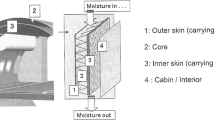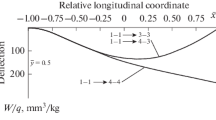Abstract
Thermoelastic stress analysis (TSA) is used to derive the surface stresses in large sandwich structure panels with honeycomb core and carbon fibre face sheets. The sandwich panels are representative of those used for secondary aircraft structure. The panels were subjected to a pressure load, similar to that experienced in-service, using a custom designed test rig. To achieve the necessary adiabatic conditions for TSA, cyclic loading is regarded as an essential feature. As the panels were full-scale, the maximum loading frequency that could be imparted to the panels by the rig was 1 Hz, which is below the usual range recommended to achieve adiabatic behaviour. To assess the effectiveness of TSA at low frequencies two approaches to calibration are investigated and compared with the stress distribution obtained from independently validated FE models. The thermoelastic response was calibrated into stress data using thermoelastic constants derived experimentally from tensile strips of the sandwich panel face sheet material. It is shown that by using thermoelastic constants obtained from the tensile strips manufactured with the same lay-up as the sandwich panel face sheets, and at the same cyclic load frequency used in the full-scale tests, quantitative stress metrics can be derived from the TSA data. More significantly, a deeper insight into the importance of the thermal characteristics in TSA of laminated materials is provided. It is demonstrated that, for the material used in this work, it is possible to use the global material behaviour to obtain quantitative results when adiabatic conditions do not prevail.









Similar content being viewed by others
References
Stanley P, Chan WK (1988) The application of thermoelastic stress analysis to composite materials. J Strain Anal Eng 23(3):137–142
Diaz FA, Patterson EA, Tomlinson RA, Yates JR (2004) Measuring stress intensity factors during fatigue crack growth using thermoelasticity. Fatig Fract Eng M 27(7):571–584
Lin ST, Miles JP, Rowlands RE (1997) Image enhancement and stress separation of thermoelastically measured data under random loading. Exp Mech 37(3)
El-Hajjar R, Haj-Ali R (2003) A quantitative thermoelastic stress analysis method for pultruded composites. Compos Sci Tech 63(7):967–978
Emery TR, Dulieu-Barton JM, Earl J, Cunningham PR (2008) A generalised approach to the calibration of orthotropic materials for thermoelastic stress analysis. Compos Sci Tech 68(3–4):743–752
Paynter RJH, Dutton AG (2003) The use of a second harmonic correlation to detect damage in composite structures using thermoelastic stress measurements. Strain 39(2):73–78
Dulieu-Smith JM, Quinn S, Shenoi RA, Read PJCL, Moy SSJ (1997) Thermoelastic stress analysis of a GRP tee joint. Appl Compos Mater 4(5):283–303
Crump DA, Dulieu-Barton JM, Savage J (2010) The manufacturing procedure for aerospace secondary sandwich structure panels. J Sandw Struct Mater 12, doi:1099636208104531
Johannes M, Dulieu-Barton JM, Bozhevolnaya E, Thomsen OT (2008) Characterisation of local effects at core junctions in sandwich structures using thermoelastic stress analysis. J Strain Anal Eng Des 43(6):469–492
Crump DA, Dulieu-Barton JM, Savage J (2010) Design and commission of an experimental test rig to apply a full-scale pressure load on composite sandwich panels representative of an aircraft secondary structure. Meas Sci Tech, 21, p 16, doi:1088/0957-0233/21/1/015108
Wong AKL (1991) A non-adiabatic thermoelastic theory for composite laminates. J Phys Chem Solid 52(3):483–494
Crump DA, Dulieu-Barton JM (2010) Analysis of large scale composite components using TSA at low cyclic frequencies. In: SEM Annual conference and exposition on experimental and applied mechanics
Sambasivam S, Quinn S, Dulieu-Barton JM (2009) Identification of the source of the thermoelastic response from orthotropic laminated composites. 17th International Conference on Composite Materials (ICCM17), Edinburgh, 11 pages on CD
Sambasivam S (2009) Thermoelastic stress analysis of laminated composite materials. University of Southampton, Faculty of Engineering, Science and Mathematics, Doctoral Thesis
Pitarresi G, Galietti U (2010) A quantitative analysis of the thermoelastic effect in CFRP composite materials. Strain 46(5):446–459
Daniel IM, Ishai O (1994) Engineering mechanics of composite materials. Oxford University Press
Pitarresi G, Found MS, Patterson EA (2005) An investigation of the influence of macroscopic heterogeneity on the thermoelastic response of fibre reinforced plastics. Compos Sci Tech 65:269–280
Shimazaki Y, Hojo F, Takezawa Y (2008) Preparation and characterization of thermoconductive polymer nanocomposite with branched alumina nanofiber. Appl Phys Lett 92
Kalogiannakis G, Van Hemelrijck D, Van Assche G (2004) Measurements of thermal properties of carbon/epoxy and glass/epoxy using modulated temperature differential scanning calorimetry. J Compos Mater 38(2):163–175
Cease H, Derwent PF, Diehl HT, Fast J, Finley D (2006) Measurement of mechanical properties of three epoxy adhesives at cryogenic temperatures for CC construction. Fermilab-TM-2366-A
Acknowledgements
The authors are grateful to GE Aviation and particularly Mr John Savage for supporting this work. The support of the technicians in the University of Southampton Engineering Design and Manufacturing Centre and the Transport Systems Research Laboratory in the design and commissioning of the test rig is also gratefully acknowledged.
Author information
Authors and Affiliations
Corresponding author
Rights and permissions
About this article
Cite this article
Crump, D.A., Dulieu-Barton, J.M. Assessment of Non-adiabatic Behaviour in Thermoelastic Stress Analysis of Composite Sandwich Panels. Exp Mech 52, 829–842 (2012). https://doi.org/10.1007/s11340-012-9601-9
Received:
Accepted:
Published:
Issue Date:
DOI: https://doi.org/10.1007/s11340-012-9601-9




